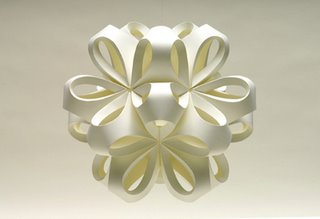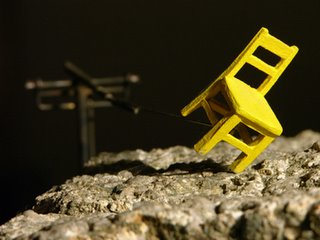Monday, December 24, 2007
Friday, October 26, 2007
Friday, October 5, 2007
Sony Bravia Bunnies: Stollen?
 Months ago, Hunter Slaton sent me a link to the Sony Bravia Bouncy Balls commercial, wherein 250,000 superballs (almost all of the bouncy balls available in the country at the time) are rolled down a steep San Francisco hill. It's really quite amazing.
Months ago, Hunter Slaton sent me a link to the Sony Bravia Bouncy Balls commercial, wherein 250,000 superballs (almost all of the bouncy balls available in the country at the time) are rolled down a steep San Francisco hill. It's really quite amazing.Now, Sony has released another ad, this time featuring Play-Doh bunnies taking over New York. Although you can't really tell, the commercial also features a little bit of plagiarism. Yikes.
Wednesday, September 5, 2007
Design Observer: What Everyone Wants
 "Perhaps design is the field of mindless prettiness. But hasn't it always been so? After all, most of us entered the profession not because we've determined after long thought that it represented a more effective way of influencing the course of world events than, say, law or medicine. Instead, somewhere along the way, we discovered we liked making things look good, and that we were better at it than other people."
"Perhaps design is the field of mindless prettiness. But hasn't it always been so? After all, most of us entered the profession not because we've determined after long thought that it represented a more effective way of influencing the course of world events than, say, law or medicine. Instead, somewhere along the way, we discovered we liked making things look good, and that we were better at it than other people.""interestingly, almost every designer I've ever met has been serenely confident in his or her ability to make things look good, thank you very much. No, what designers wanted then and want now, more than anything else, is respect. Respect from clients. Respect from the general public. We want to be seen as more than mere stylists, we want to set the agenda, to be involved earlier in the strategic process, to be granted a place at the table. In short, just like the Chaste Clarissa, we want to be taken seriously."
Saturday, August 25, 2007
Nathan Sawaya - The Art of Brick

Click on the image to view more...
I don't think there was another solo activity I did when I was little that was as enriching and well-spent as when I was constructing Legos. Playing in the back yard, riding my bike, sitting in front of the television - for shows or video games. All of these activities seem inferior when I think of the calm I used to feel when I played with Legos. In fact, there are times when I think I might be better off now if I just had a carrying case of Legos to fool around with.
Saturday, August 18, 2007
Saturday, August 11, 2007
Zune Planes
At the Bust Magazine Holiday Craftacular in NYC last year, I had a chance to play with the Zune, Microsoft's answer to the iPod. I wasn't floored by Zune. Unlike the iPod, I didn't feel an intense need to own one after holding it. But, similar to Apple's ads, Zune commercials make me want to buy. Check out this great ad by Fulltank:
Wednesday, August 8, 2007
Plain Mary: High Retailers
 In the September 2007 issue of Dwell magazine, the following ad appears on page 250:
In the September 2007 issue of Dwell magazine, the following ad appears on page 250:"Plain Mary is an iconic baby brand that merges utility with keepsake quality design. Our standards are high, as should be the retailers who carry our line."
I think their tagline should be: "Plain Mary: High Standards, High Retailers, Sober Babies."
Thursday, July 26, 2007
Full of Beauty
 A conversation that just took place over IM about the above paper sculpture by Richard Sweeney:
A conversation that just took place over IM about the above paper sculpture by Richard Sweeney:Coworker [2:41 PM]: so this is paper?
Me [2:44 PM]: Yeah. I read somewhere that it's the 3D expression of a geometric equation in a CAD program.
Me [2:47 PM]: (after finding the information online) it's a "Paper structure exploring the principle of fractal geometry, upon which forms in nature are generated."
Coworker [2:47 PM]: it just goes to show that math is beautifull
Me [2:48 PM]: So is spelling.
Coworker [2:48 PM]: Huh?
Me [2:49 PM]: Nevermind.
Friday, July 20, 2007
Arthur Ganson
Take a look at the incredible work of an industrial artist named Arthur Ganson, who makes these unbelievable sculptures that mingle life with machine.
Sunday, July 8, 2007
The Q Drum
 The Cooper-Hewitt National Design Museum has an exhibition entitled "Design for the Other 90%" through September 23rd, 2007. From the website:
The Cooper-Hewitt National Design Museum has an exhibition entitled "Design for the Other 90%" through September 23rd, 2007. From the website:"Encompassing a broad set of modern social and economic concerns, these design innovations often support responsible, sustainable economic policy. They help, rather than exploit, poorer economies; minimize environmental impact; increase social inclusion; improve healthcare at all levels; and advance the quality and accessibility of education. These designers’ voices are passionate, and their points of view range widely on how best to address these important issues. Each object on display tells a story, and provides a window through which we can observe this expanding field. Design for the Other 90% demonstrates how design can be a dynamic force in saving and transforming lives, at home and around the world."Take a look at The Q Drum.
Saturday, July 7, 2007
Juicy Salif
 Among the many design items that I dream of owning but cannot afford is Juicy Salif. At ~$80, I can't yet justify spending that much on a manual fruit juicer. However, the design is beautiful and fascinating. I love that the ridges in the body both help to squeeze the juice out of the fruit and channel it to a point just above the mouth of a glass. My favorite aspect of it is the upward direction of the legs, right above the attachment; if they were downward-facing, juice would run down the legs. When held, even the weight of this item is satisfying.
Among the many design items that I dream of owning but cannot afford is Juicy Salif. At ~$80, I can't yet justify spending that much on a manual fruit juicer. However, the design is beautiful and fascinating. I love that the ridges in the body both help to squeeze the juice out of the fruit and channel it to a point just above the mouth of a glass. My favorite aspect of it is the upward direction of the legs, right above the attachment; if they were downward-facing, juice would run down the legs. When held, even the weight of this item is satisfying.
Thursday, June 28, 2007
Online Color for the Colorblind
 I am red/green colorblind, which means that I have a hard time distinguishing purple from blue and some greens from browns. When a color stands alone, I am likely to guess the color wrong; I think of this as a kind of color dyslexia. I'm always amazed by the reactions I get when I tell people this. If they don't assume that I can't see color at all, they usually start pointing at different things and asking what color they are.
I am red/green colorblind, which means that I have a hard time distinguishing purple from blue and some greens from browns. When a color stands alone, I am likely to guess the color wrong; I think of this as a kind of color dyslexia. I'm always amazed by the reactions I get when I tell people this. If they don't assume that I can't see color at all, they usually start pointing at different things and asking what color they are.I avoid color as a result.
However, I've found some great online resources for color exploration: Kuler, a site from Adobe that asks people to assemble color combinations and vote on the most popular.
And here is a Colorblind Webpage Filter, so you can see things as I do.
Saturday, June 23, 2007
The National Design Museum
 Joli and I recently visited the The Cooper-Hewitt National Design Museum in NYC. The exhibition when we were there was called "Made to Scale: Staircase Masterpieces." From the website:
Joli and I recently visited the The Cooper-Hewitt National Design Museum in NYC. The exhibition when we were there was called "Made to Scale: Staircase Masterpieces." From the website: "The models, the majority of them from 19th-century France, represented exercises in technical virtuosity, demanding knowledge of cantilevering, balance, forms of rotation, styles of balusters and other architectural details. In their combination of design, structural, architectural and cabinetry skills, the staircase models and accompanying drawings demonstrate the relationship between formal training, modeling, technical mastery and flights of creative fancy.But one of the best parts of the visit was the gift shop. I could easily spend a few paychecks in that tiny store.
Home Manufacturing
 For ages, I've wanted to learn how to use CAD drawing software. In the past, when I've come up with a design idea, I've had to sketch it out with pencil and paper, the result of which is so poorly rendered that I'm tempted to scrap the entire project. I've used paperboard from shoe boxes to do 3D modeling. In the last few years, I've even used Paint. (Said one friend, "Yeah, Paint is great software... if you're a five-year-old.")
For ages, I've wanted to learn how to use CAD drawing software. In the past, when I've come up with a design idea, I've had to sketch it out with pencil and paper, the result of which is so poorly rendered that I'm tempted to scrap the entire project. I've used paperboard from shoe boxes to do 3D modeling. In the last few years, I've even used Paint. (Said one friend, "Yeah, Paint is great software... if you're a five-year-old.")Well, now I use Google's free CAD software, Sketchup, which allowed me to make this 3D model of my living room (Sketchup installation required): Living Room.skp
I've also designed a metal bracket that functions as a picture frame (patent pending). In order to make a prototype, I'll be sending my design files to a company called Big Blue Saw. These "rapid prototyping" companies are popping up all over the place. But if you're going to be doing a lot of inventing, you could always buy yourself a 3D printer.
Subscribe to:
Posts (Atom)



